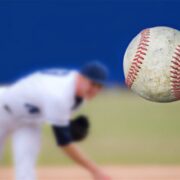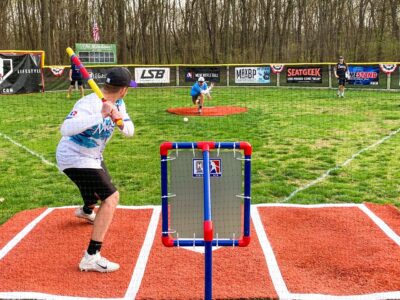In this article, we will discuss how to play wiffleball on a 45ft field. Wiffleball is a great sport that can be played with just about anyone.
It’s also one of the most popular games at summer camps and parties! We’ll go over how to make a wiffleball field, what you need to play, and some tips for playing the game!
What is Wiffleball?
Wiffleball is a bat-and-ball game played primarily in North America that simulates the casual game of baseball.
It was created in 1952 by David N. Mullany Jr., an executive at the Wm. T. Walters Company, which manufactured latex balloons in Wilshire, Los Angeles, California for 6 years and later formed a toy company called Wham-O!
What Does a Wiffleball Look Like?
A Wiffleball is a soft, typically plastic, hollow sphere and has holes in it. The design of the small-diameter hole at the end of the ball causes less air resistance than an equivalent-sized solid rubber or metal sphere with no holes so that when pitched from close to a batter’s head there is enough backspin on the ball to produce a true long fly.
Equipment Needed to Play Wiffleball:
- A Wifflebat (each player needs their own)
- At least one Wiffleball per player, and
- An outdoor area with at least 45 ft of space.
How Many Players Are on A-Team?

The game can be played by two or more players on teams who take turns tossing the ball in the air to each other.
How To Set Up the Field?
A Wiffleball field is set up with a base on either side and the pitcher’s mound in the center. Use cones or other markers to mark off boundaries of the playing area (usually 45 ft).
The bases are typically 15 feet from each other but can be adjusted depending on how many players you have participated. The pitcher’s mound is farther from home plate than in the game of baseball.
How To Play Wiffleball on A 45ft Field
- Choose a team in which every player will have their own Wiffle bat and ball.
- Divide players into two teams with one or more captains for each side, who should stand at either home plate. All the other participants should line up on the outside of the playing area (at least 45 ft from home base). The captains should choose their teams by alternating turns, with one captain throwing the ball to a player on his/her team.
- For each round of play, every player will get up and take two steps towards the home base as soon as they catch the ball from the opposing team’s captain (or any other member).
- Once all players have picked up the ball and taken two steps, one of the captains should throw it to a player on his/her team.
- Once both teams have had their turn catching and throwing, players will switch sides and roles with each other.
- After every round (or if there is no need for multiple rounds), the winning side will designate an “out” player. The “out” player will then get up and take two steps towards the home base as soon as they catch the ball from an opposing team’s captain or any other member of their own side
- Once all players have picked up the ball, the captains will throw it back to each other until one catches a fly out (the catcher should be at home plate for this)
- The winning team is determined by whichever side has caught more flyouts. If both sides have caught a few flyouts that are equal, then no one wins, and players can choose to either start again or switch roles with each other.
- While it’s not required, you can keep track of points by keeping a score of the number of flies outs each team catches.
What Are the Different Positions in Wiffleball?
- There are four outfielders, and one player designated as a pitcher. The three other players on defense work together to cover home plate while they wait for the pitch:
- The catcher is positioned behind the home plate with his/her back to the batter. He or she catches the ball in contact with the bat and tries to throw out runners who are trying to steal home plate.
- The first baseman is positioned in front of the baseline near the first base, waiting for any balls that get past or do not make it over the infield.
- One or more middle infielders stand between second and third base, waiting for balls to arrive.
- The third baseman is positioned on the outside corner of their team’s territory near the third base and waits for any balls that get past or do not make it over the infield.
- One outfielder defends each area in the foul ground: left field (near first base), center field (between home plate and second base), and right field (near third).
- The pitcher, who stands on the pitcher’s mound about 60 feet from home plate in foul territory, throws pitches to be hit by the batter.
Rules Of the Game
- The pitcher throws a ball to the batter, and this is called a pitch.
- When either of these two things happens:
- Four balls have been pitched to the same player or
- Three strikes have been thrown at that player; he can make one more attempt to bat without being penalized with an out.
- The batter calls time out to receive instructions from the coach.
- If a player is touched with the ball while he/she is not touching either base, a fielder makes an out and throws him or her back to their original team’s side of the field. The runner must return to his or her previous base before attempting another advance.
- If a player is touched with the ball while touching one of his or her bases, it is called an out and he/she must return to that base before attempting another advance.
- When three outs are recorded on one team (either from catches by players on defense, or tags made in running), then their opponents win the game.
- The player on defense is out if he or she is touched by a ball while not touching either base, or when three outs are recorded against them (either from catches by players on their team, or tags made in running).
- It’s an out for the batter and any runners who have already advanced at least one base when they are tagged by a fielder, or if the ball is caught on contact.
- An out is called for any player who has touched their base and then touches it again after advancing at least one way past that same base (beyond first) before another runner advances from their team’s side of the field to home plate.
- Home plate is a point on the field, and one runner can score by touching it without being tagged while any other runners are in progress on their bases.
Conclusion
We hope you’ve enjoyed learning about the basics of Wiffleball. Now get out there and have some fun! Remember, if you’re playing at 45 feet away from home base, try to stay in the outfield so that your teammates can cover more ground on defense.
Also, remember to keep it low when throwing pitches – this will help avoid pop flies which are easy for opponents to catch. If anyone ever has a question or feedback about our blog post, please feel free to contact us via email or social media channels.










Comments